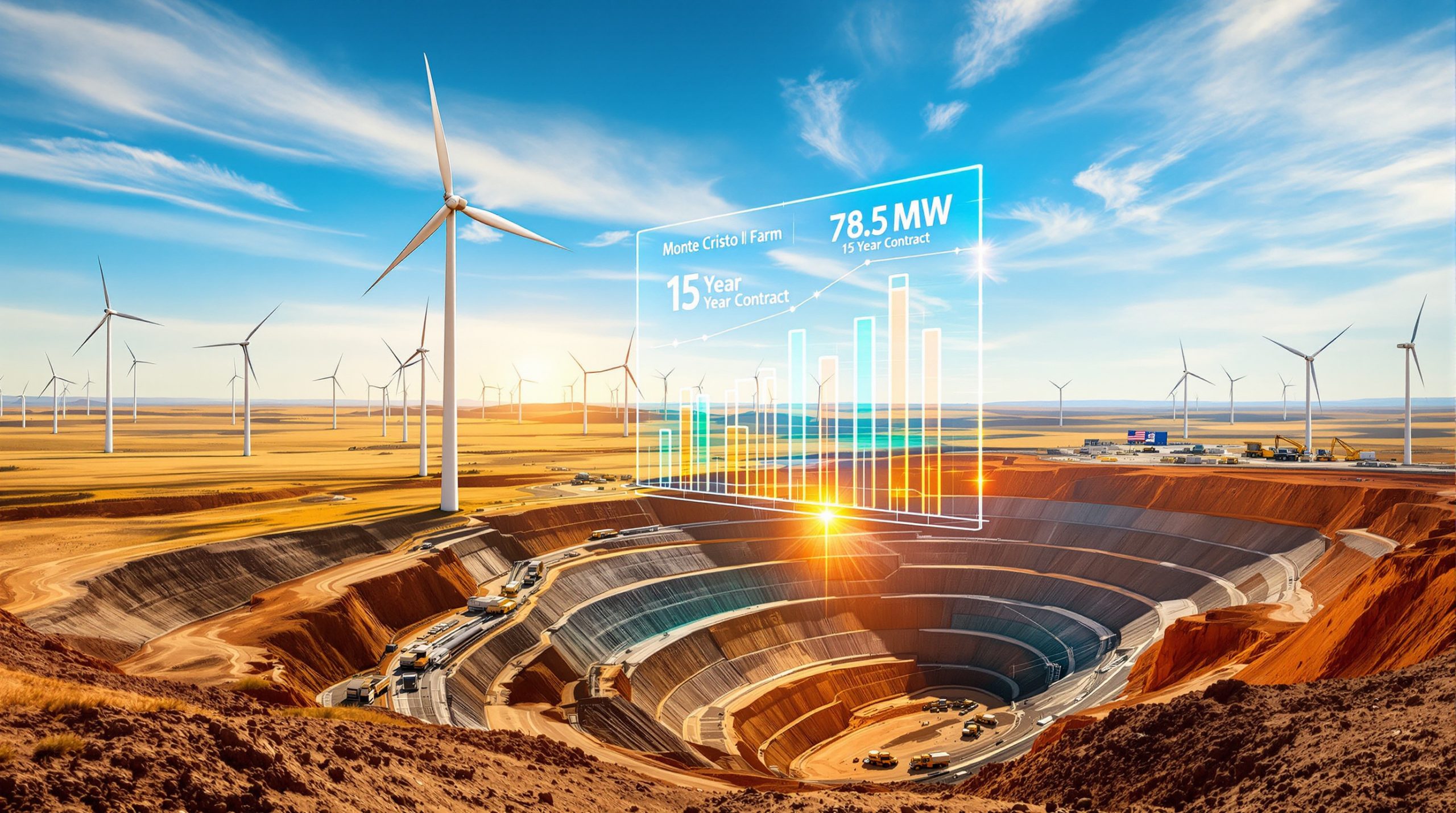Rio Tinto's groundbreaking rio tinto wind power deal with TerraGen marks a significant milestone in the mining sector's renewable energy adoption, demonstrating how major corporations can leverage virtual power purchase agreements to advance their sustainability objectives while maintaining operational excellence.
Understanding Virtual Power Purchase Agreements in Mining Operations
Virtual Power Purchase Agreements have emerged as a strategic mechanism for mining companies seeking renewable energy without the complexities of direct infrastructure ownership. These financial contracts enable corporations to secure long-term renewable electricity at fixed prices while maintaining operational flexibility across their facilities.
What Makes VPPAs Attractive for Industrial Operations
A Virtual Power Purchase Agreement functions as a contract for differences between market electricity prices and predetermined renewable energy rates. When market prices exceed the agreed VPPA rate, renewable facility owners compensate buyers with the difference. Conversely, if market prices fall below the VPPA price, buyers pay the premium to generators.
The global corporate VPPA market reached approximately $19 billion in 2023, with North American operations accounting for the largest transaction volumes. Standard contract durations typically range from 10-20 years, with 15-year terms becoming industry standard for mining operations requiring long-term cost predictability.
Mining companies utilise VPPAs to separate renewable energy purchasing from physical infrastructure management, allowing focus on core extraction and processing activities. Unlike traditional on-site installations requiring capital investment in land, infrastructure, and ongoing maintenance, VPPAs require no direct capital expenditure for renewable facilities.
Financial Benefits and Risk Mitigation Strategies
Fixed-price VPPAs demonstrate 15-25% lower cost volatility compared to spot market electricity purchases over 15-year periods. This predictability enables mining operations to forecast energy expenses with greater accuracy, supporting long-term financial planning and budgeting processes.
Furthermore, the advantages of these agreements include:
• Operational flexibility: No infrastructure investment requirements
• Grid stability contributions: Through renewable energy certificates
• Corporate sustainability reporting: Enhanced ESG rating potential
• Cost predictability: Extended contract periods reduce market volatility exposure
Major technology companies have demonstrated successful VPPA implementation strategies. Apple signed multiple agreements totalling over 4.3 GW of renewable capacity globally by 2023, offsetting approximately 100% of electricity consumption through this mechanism. Similarly, Google accumulated 7.5 GW of renewable energy VPPAs by 2023 across multiple countries supporting data centre operations.
Why Mining Companies Choose Virtual Power Deals
Mining operations require substantial, consistent electricity consumption for continuous extraction, processing, and refining activities. Traditional utility contracts expose these operations to market price fluctuations and regulatory changes that can significantly impact operational costs.
As of 2024, approximately 35% of major mining operations have active renewable energy procurement strategies, with VPPAs representing 42% of new mining sector renewable energy commitments. This adoption rate reflects growing recognition of VPPAs as viable alternatives to traditional power procurement methods alongside sustainable mining practices.
Mining companies with documented renewable energy procurement show average ESG rating improvements of 3-5 points on 100-point scales. These improvements translate into enhanced investor relations, improved lending terms, and strengthened customer relationships with sustainability-focused partners.
VPPAs contribute to mining companies' Scope 2 emissions reduction more efficiently than waiting for entire regional grids to transition towards renewable sources. Contract compliance metrics typically include 95-98% availability guarantees, real-time performance monitoring, and graduated penalty clauses for underperformance.
Rio Tinto's Strategic Energy Transition at Kennecott Operations
Breaking Down the TerraGen Partnership Details
Rio Tinto's latest renewable energy initiative involves a comprehensive 15-year virtual power purchase agreement with TerraGen, commencing commercial operations in November 2025. This strategic partnership allocates 78.5 MW of renewable capacity from the Monte Cristo I Windpower project's total 238.5 MW generation capacity.
| Contract Specifications | Details |
|---|---|
| Contract Duration | 15 years |
| Rio Tinto's Allocation | 78.5 MW |
| Total Project Capacity | 238.5 MW |
| Project Location | Texas, USA |
| Beneficiary Operation | Kennecott Copper Mine, Utah |
| Commercial Operations Date | November 2025 |
The Monte Cristo I Windpower project represents a significant addition to Texas renewable energy infrastructure, with Rio Tinto securing approximately 33% of total generation capacity. This cross-state arrangement demonstrates how VPPAs enable mining operations to access superior wind resources without geographic constraints.
TerraGen's wind facility leverages Texas's exceptional wind resource quality, where average capacity factors range from 35-45% compared to typical U.S. solar installations averaging 25-30%. The project completed all development phases, including permitting, construction, and grid interconnection, by the November 2025 ribbon-cutting ceremony.
Cross-State Transmission and Grid Integration
The VPPA structure enables Kennecott's Utah operations to benefit from Texas wind generation through ERCOT (Electric Reliability Council of Texas) and interconnected grid systems. This arrangement functions through financial energy settlement rather than physical power delivery, providing operational flexibility while securing renewable energy benefits.
Rio Tinto Kennecott Managing Director Nate Foster emphasised that this agreement strengthens the company's renewable energy portfolio in the United States while supporting continued growth of greenfield renewable energy generation capacity across the national grid system.
Kennecott's Renewable Energy Portfolio Evolution
Kennecott's renewable energy strategy demonstrates progressive portfolio development combining on-site generation with virtual power purchases. The operation installed a 5 MW solar facility in 2023, representing the initial phase of renewable energy integration.
Current expansion includes a 25 MW solar project in advanced development stages, nearing operational commencement. When combined with the 78.5 MW wind power capacity through the TerraGen VPPA, Kennecott's total committed renewable energy portfolio reaches approximately 108.5 MW.
• 2023: 5 MW solar installation operational
• 2024-2025: 25 MW solar project nearing completion
• 2025 onwards: 78.5 MW wind power via VPPA
• Total Portfolio: 108.5 MW renewable capacity
This hybrid approach optimises different operational and financial characteristics of solar and wind technologies. On-site solar installations provide immediate self-consumption benefits and avoid transmission losses, while off-site wind via VPPA leverages superior wind resources without capital infrastructure requirements.
Portfolio diversification across solar and wind resources provides weather pattern and seasonal generation variation benefits, improving overall power supply reliability for continuous mining operations requiring consistent electricity availability.
How This Deal Advances Global Mining Decarbonisation Goals
Rio Tinto's Emission Reduction Roadmap
Rio Tinto's comprehensive decarbonisation strategy positions the company among industry leaders pursuing ambitious emission reduction targets. Currently sourcing 78% of global electricity consumption from renewable sources, the company targets increasing renewable electricity to approximately 90% across global operations by 2030.
The mining giant committed to 50% reduction in Scope 1 and Scope 2 emissions by 2030, compared to 2018 baseline measurements. Additionally, Rio Tinto established net zero greenhouse gas emissions commitment by 2050, aligning with international climate accord objectives through energy transition strategies.
Scope Emissions Classification and Impact
Mining operations' electricity consumption typically represents 25-40% of total Scope 1+2 emissions, depending on ore body depth and processing intensity requirements. Scope 1 emissions include direct operations-controlled greenhouse gas emissions from diesel generators and on-site fuel combustion. Scope 2 covers indirect emissions from purchased electricity.
"Strategic Insight: Renewable electricity procurement through VPPAs and on-site generation directly reduces Scope 2 emissions attributable to grid electricity consumption, providing measurable progress toward corporate climate commitments."
The Kennecott VPPA represents tactical implementation within Rio Tinto's broader portfolio strategy, contributing approximately 0.7-1.0% towards the 90% renewable target when fully operational. This incremental progress demonstrates how individual facility agreements aggregate into company-wide emission reduction achievements.
Comparing Mining Industry Energy Transition Strategies
Rio Tinto's sequential renewable energy expansion strategy demonstrates pragmatic decarbonisation balancing operational continuity with climate commitments. Similar approaches across the mining sector reveal different tactical implementations of renewable energy integration.
BHP Group achieved 74% renewable electricity by 2023, targeting 100% by 2030 through combined VPPA and on-site renewable strategies. Teck Resources reported 51% renewable electricity in 2023 with 2030 targets of 100% renewable electricity for Canadian operations specifically.
| Mining Company | Current Renewable % | 2030 Target | Primary Strategy |
|---|---|---|---|
| Rio Tinto | 78% | 90% | Hybrid VPPAs + On-site |
| BHP Group | 74% | 100% | VPPAs + Direct Investment |
| Teck Resources | 51% | 100% (Canada) | Regional Focus |
These comparative approaches demonstrate industry-wide recognition that renewable energy transition requires flexible procurement strategies adapted to specific operational requirements, geographic locations, and regulatory environments.
What Makes Texas Wind Power Attractive for Mining Operations
Texas Renewable Energy Market Advantages
Texas offers exceptional wind resource quality with consistent generation patterns supporting industrial operations requiring reliable electricity supply. The state's wind resources achieve average capacity factors of 35-45%, significantly exceeding national averages and providing predictable generation patterns essential for mining operations.
ERCOT's transmission infrastructure capabilities enable large-scale renewable energy distribution across regional and interstate connections. This robust grid system supports corporate VPPAs by facilitating renewable energy certificate transfers and financial settlements between generation facilities and end-use customers.
Regulatory Environment Supporting Long-Term Contracts
Texas regulatory framework encourages long-term renewable energy contracts through streamlined permitting processes and grid interconnection procedures. The state's deregulated electricity market enables direct negotiations between renewable energy developers and corporate customers, reducing regulatory complexity compared to traditionally regulated utility markets.
Cost competitiveness positions Texas wind power among the most economical renewable energy options nationally. However, wholesale electricity prices in ERCOT frequently demonstrate wind power's ability to compete with traditional generation sources, providing corporate buyers with cost-effective renewable energy access.
Geographic Diversification Benefits
Cross-state VPPAs enable mining companies to access optimal renewable resources regardless of mine location constraints. This rio tinto wind power deal demonstrates how Utah mining operations can benefit from Texas wind generation through financial mechanisms rather than physical proximity requirements.
• Risk reduction: Multi-state renewable energy sourcing
• Grid reliability: Improvements across different regions
• Weather diversification: Consistent power supply through distributed resources
• Supply chain resilience: Distributed energy partnerships
Weather pattern diversification provides consistent power supply benefits when renewable generation varies seasonally or due to local weather conditions. Texas wind resources complement solar generation patterns in other regions, creating more stable renewable energy portfolios for industrial customers.
Financial and Operational Impact Analysis
Cost Structure Transformation Through VPPAs
Traditional energy procurement exposes mining operations to market volatility, regulatory changes, and fuel cost fluctuations that can significantly impact operational budgets. VPPAs provide fixed-price electricity agreements insulating corporate buyers from short-term market variations while securing long-term cost predictability.
Long-term budget predictability enables mining companies to forecast energy expenses with greater accuracy over multi-year planning periods. Fixed-price agreements typically demonstrate 15-25% lower cost volatility compared to spot market electricity purchases, supporting more accurate financial modelling and investment planning.
Capital Allocation Efficiency Analysis
VPPAs require no direct capital expenditure for renewable facility development, construction, or ongoing maintenance responsibilities. This capital efficiency enables mining companies to allocate investment resources towards core operational improvements, equipment upgrades, and expansion projects rather than energy infrastructure development.
| VPPA Benefits | Traditional On-Site | VPPA Approach |
|---|---|---|
| Capital Requirements | $2-4 million per MW | $0 per MW |
| Operational Responsibility | Full facility management | Contract compliance only |
| Geographic Flexibility | Limited to site location | Access to optimal resources |
| Maintenance Costs | Ongoing operational expense | Included in contract price |
Inflation protection through fixed-price agreements shields mining operations from energy cost increases that might otherwise compress profit margins during commodity price downturns. This financial stability becomes particularly valuable during multi-year commodity cycles.
Operational Efficiency Considerations
Power supply reliability through diversified energy portfolios reduces single-point-of-failure risks associated with dependence on individual utility providers or generation sources. Grid integration challenges require careful coordination between VPPA providers and existing utility connections to ensure seamless power supply continuity.
Performance monitoring systems enable real-time tracking of renewable energy generation and contract compliance metrics. These systems provide transparency into actual versus projected electricity production, supporting operational planning and budget forecasting accuracy.
How Other Major Miners Can Replicate This Strategy
VPPA Implementation Framework for Mining Companies
Mining companies considering VPPA strategies must conduct comprehensive energy demand assessments forecasting electricity requirements over 15-20 year contract periods. This analysis includes current consumption patterns, planned operational expansions, and processing equipment upgrades affecting future electricity needs.
Renewable energy project evaluation requires assessment of generation reliability, transmission access, and grid interconnection capabilities. Successful VPPA implementation depends on selecting renewable facilities with proven technology, experienced developers, and robust grid connections supporting long-term operational requirements.
Contract Negotiation Best Practices
Risk allocation negotiations determine responsibility distribution for performance shortfalls, transmission constraints, and regulatory changes affecting contract performance. Balanced risk allocation protects both mining companies and renewable energy developers from unforeseen circumstances while maintaining economic viability.
Integration with existing power infrastructure requires coordination between VPPA providers, utility companies, and mining operations to ensure seamless electricity supply transitions. This integration planning addresses backup power requirements, grid connection protocols, and emergency response procedures.
Scalability Across Different Mining Operations
Underground mining operations typically require 40-60 MW electricity consumption for ventilation, hoisting, and processing equipment. Surface mining operations may require 100-300 MW for dragline equipment, conveyors, and processing facilities. VPPA sizing must align with specific operational electricity demands.
• Site assessment: Energy demand forecasting over contract duration
• Project evaluation: Renewable facility reliability and grid access
• Contract structure: Risk allocation and performance guarantees
• Grid integration: Coordination with existing power infrastructure
Remote mining locations present transmission challenges requiring careful evaluation of grid connectivity and renewable energy certificate transfer mechanisms. Multi-site mining companies can aggregate electricity demands across operations to achieve larger VPPA contract sizes with improved economic terms.
Broader Industry Implications and Future Trends
Mining Sector Energy Transition Acceleration
Investor pressure increasingly drives renewable energy adoption across mining operations as ESG criteria influence capital allocation decisions. Major institutional investors now require comprehensive climate risk disclosure and emission reduction strategies as prerequisites for investment consideration.
Supply chain sustainability requirements from downstream customers create additional pressure for mining companies to demonstrate renewable energy procurement. Steel manufacturers, automotive companies, and electronics producers increasingly specify low-carbon raw materials in procurement specifications.
Government Policy Incentives Supporting Clean Energy Transitions
Federal and state tax incentives support renewable energy development through production tax credits, investment tax credits, and accelerated depreciation schedules. These policy mechanisms reduce renewable energy costs, making VPPAs more economically attractive for corporate buyers.
Competitive advantages from early renewable energy adoption include preferential lending terms from ESG-focused financial institutions, enhanced brand reputation, and improved relationships with sustainability-conscious customers and communities. Furthermore, companies are exploring battery metals trends to support their transition strategies.
Technology Integration Opportunities
Battery storage systems complement wind power agreements by smoothing generation variability and providing grid services supporting renewable energy integration. Advanced storage technologies enable mining operations to optimise renewable energy utilisation patterns matching electricity demand with generation availability.
Smart grid technologies support renewable energy utilisation optimisation through real-time demand response, predictive analytics, and automated load management systems. These technologies maximise renewable energy value while maintaining operational reliability requirements.
• Battery storage integration: Smoothing renewable generation variability
• Smart grid optimisation: Real-time demand response capabilities
• Predictive analytics: Improved energy demand forecasting accuracy
• Automation systems: Reduced overall energy consumption through efficiency
Predictive analytics improve energy demand forecasting by analysing historical consumption patterns, production schedules, and weather data affecting electricity requirements. These analytical capabilities support more accurate VPPA sizing and contract structuring.
What This Means for Investors and Stakeholders
Investment Implications for Rio Tinto
ESG rating improvements through renewable energy expansion enhance Rio Tinto's attractiveness to sustainability-focused institutional investors representing trillions in managed assets. These improvements translate into potentially lower borrowing costs, expanded investor base access, and enhanced market valuation multiples.
Long-term cost stability supports profit margin predictability during commodity price volatility periods. Fixed-price renewable energy contracts provide partial insulation from energy cost inflation, supporting more stable operational cash flows over multi-year commodity cycles.
Market Signal Analysis
This rio tinto wind power deal demonstrates mining industry acceleration towards energy transition implementation rather than preliminary planning phases. This strategic shift signals investor expectations for concrete emission reduction actions supported by measurable renewable energy procurement agreements.
Renewable energy project demand from industrial customers strengthens development economics for wind and solar facilities nationwide. Corporate VPPA agreements provide revenue certainty enabling project financing and construction across regions with suitable renewable resources.
Texas Wind Power Market Growth Drivers
Corporate partnerships drive Texas wind power market expansion through guaranteed revenue streams supporting project development financing. Mining companies, technology firms, and manufacturing operations increasingly recognise Texas wind resources as cost-effective renewable energy options.
Virtual power purchase agreement market expansion trends indicate growing corporate acceptance of off-site renewable energy procurement strategies. This market development reduces dependence on utility renewable energy programmes while providing corporations greater control over sustainability objectives, particularly as mining industry innovation continues to advance.
| Stakeholder Group | Primary Benefits | Key Considerations |
|---|---|---|
| Rio Tinto Shareholders | ESG improvement + cost stability | Contract performance risk |
| Renewable Developers | Revenue certainty | Long-term operational requirements |
| Texas Grid | Increased renewable capacity | Transmission infrastructure needs |
| Mining Industry | Best practice examples | Replication scalability |
Measuring Success: Key Performance Indicators
Environmental Impact Metrics
Annual CO2 emission reductions from wind power integration provide quantifiable progress towards Rio Tinto's 2030 and 2050 climate targets. The 78.5 MW wind allocation through the TerraGen VPPA generates approximately 200,000-250,000 MWh annually, reducing Scope 2 emissions by an estimated 100,000-150,000 tonnes CO2 equivalent.
Percentage increases in renewable energy portfolio mix demonstrate measurable progress towards the 90% renewable electricity target by 2030. Each additional renewable energy agreement contributes incremental improvements supporting comprehensive emission reduction strategy implementation.
Financial Performance Tracking
Energy cost stability comparisons between VPPA pricing and traditional utility rates provide ongoing validation of procurement strategy effectiveness. Fixed-price renewable energy contracts enable budget variance reduction through predictable electricity costs over 15-year contract periods.
Return on investment calculations for VPPA commitments incorporate cost savings, ESG rating improvements, and risk mitigation benefits extending beyond direct electricity cost comparisons. These comprehensive analyses support strategic decision-making for future renewable energy procurement opportunities.
Operational Reliability Metrics
Contract compliance monitoring tracks renewable facility availability, performance guarantees, and grid integration success rates. Real-time monitoring systems provide transparency into actual versus projected generation performance supporting operational planning requirements.
• Generation performance: Actual vs. projected electricity production
• Contract compliance: Availability guarantees and penalty assessments
• Grid integration: Transmission reliability and interconnection performance
• Cost effectiveness: Budget variance tracking and savings realisation
Budget variance reduction through long-term price certainty enables more accurate financial forecasting and capital allocation planning. Predictable energy costs support investment decision-making for operational improvements and expansion projects requiring multi-year financial commitments.
Strategic Energy Partnerships Reshaping Mining
Long-term Industry Transformation
Virtual power purchase agreements are transitioning from innovative procurement strategies to standard industry practice across major mining operations. This evolution reflects growing recognition that renewable energy transition requires flexible approaches balancing operational requirements with sustainability objectives.
Mining companies increasingly function as key drivers of renewable energy development through long-term contract commitments providing revenue certainty for project financing. These partnerships accelerate renewable energy infrastructure development while supporting corporate emission reduction goals through energy fuels partnership initiatives.
Geographic Diversification Strategies
Cross-state and international VPPA opportunities enable mining companies to access optimal renewable resources regardless of operational location constraints. This geographic flexibility supports portfolio diversification reducing weather-related generation risks while maximising renewable energy economic benefits.
Collaborative approaches between mining companies and renewable energy developers create mutually beneficial partnerships supporting clean energy transition acceleration. These relationships provide mining operations with energy security while enabling renewable developers to achieve project financing and construction milestones.
Next Steps for Mining Energy Evolution
Expansion opportunities in battery storage, hydrogen production, and grid services represent potential evolution paths for mining sector renewable energy strategies. Advanced technologies may enable mining operations to provide grid stability services while optimising renewable energy utilisation patterns.
International VPPA market development supports global mining operations seeking renewable energy procurement in regions with developing renewable energy markets. Cross-border renewable energy certificate programmes may facilitate international mining companies' emission reduction strategies across diverse regulatory environments.
Industry-wide best practice sharing accelerates sustainable energy procurement adoption across mining operations of different scales and geographic locations. Collaborative knowledge transfer reduces implementation barriers while improving renewable energy integration success rates.
Moreover, major mining companies like Rio Tinto are setting precedents that others in the industry will likely follow. According to Rio Tinto's renewable energy strategy, the company's commitment to achieving 90% renewable electricity by 2030 represents one of the most ambitious targets in the mining sector. Additionally, TerraGen's renewable energy partnerships demonstrate the growing appetite for long-term collaborative agreements between mining companies and renewable energy developers.
The rio tinto wind power deal exemplifies how strategic partnerships can accelerate the mining industry's energy transition whilst maintaining operational efficiency. As more companies follow this model, the cumulative impact on global renewable energy development and emission reductions will become increasingly significant.
This analysis reflects current industry trends and available public information. Renewable energy markets and mining industry strategies continue evolving rapidly, requiring ongoing assessment of optimal procurement approaches for specific operational requirements.
Ready to Invest in the Next Major Mineral Discovery?
Discovery Alert's proprietary Discovery IQ model delivers real-time alerts on significant ASX mineral discoveries, transforming complex mineral data into actionable investment insights. Whether you're seeking short-term trading opportunities like those driven by renewable energy partnerships or long-term positions in transformative discoveries, understand why historic discoveries can generate substantial returns and begin your 30-day free trial today to position yourself ahead of the market.




